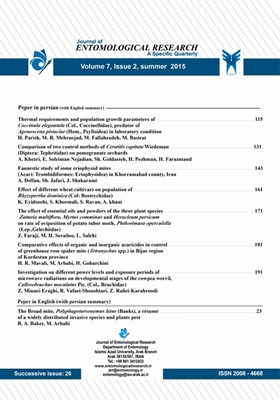Comparative effects of organic and inorganic acaricides in control of greenhouse rose spider mite (Tetranychus spp.)
Subject Areas : entomology and othea arthropodsH. R. Mavali 1 , M. Arbabi 2 , H. Goharchini 3
1 - Department of Entomology, College of Agriculture, Islamic Azad University, Arak Branch, Arak, Iran
2 - Iranian Research Institute of Plant Protection, Tehran, Iran
3 - Payam Noor University, Bijar Branch, Kordestan Province, Iran
Keywords:
Abstract :
Web spotted spider mite is a major pest of greenhouse rose varieties and maximum control achieved also through acaricides application in Iran. In concern to increase acaricidal application choices, an investigation about two doses of new organic (BioMite, GC-Mite, Kingbo), inorganic (Floramite, Danizeraba, Biok) along with cleaning agent mixed with water, carried out against rose spider mite infestation during late spring and middle of summer seasons in Bijar region of Kurdistan province of Iran. Randomized block design with three replications selected and for each replicate, 10 leaves randomly collected from different bending and vertical roses shoots. Sampling intervals followed one day before and 1, 3, 7 and 15 days after treatments during spring and summer seasons respectively. Active mite stages on lower rose’s leaf side counted with help of stereo microscope. Collected data converted into mortality% through Henderson-tilt on formula. Analysis of variance done with help SAS method and Duncan method used for ranking treatments at different interval times. Maximum mite mortality% recorded 84.61%, 91.73% one day after treatments for both danisaraba doses and effects decreased after 7 days onward for both doses. Floramite effects up to 3 days after treatments observed with considerable mite mortality% while recorded weak effects for both biok doses through sampling period. Both GC-mite doses with 67.13% and 69.14% mite control observed during late spring which reduced sustainable effects up to 40% at 15 days interval time. Detergent water treatment with 67.21% and 56.57% mite controlled after one day during spring and summer season found more effective than other organic acaricides respectively. In total, treatments effect found more significant during spring than summer seasons. Application those treatments when mean of 2-3 mites observed in 30% of the collections, will increase acaricides effects and protect further mite resistance also.


